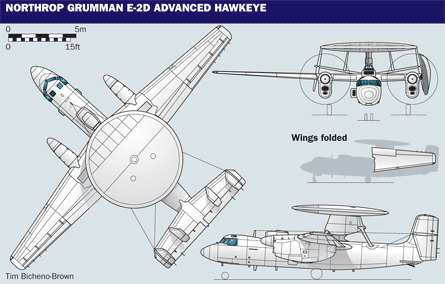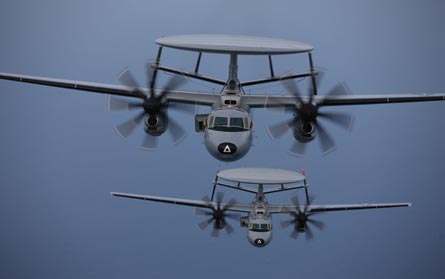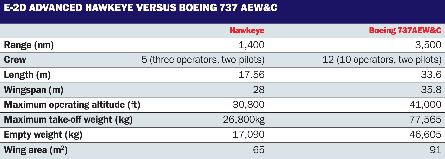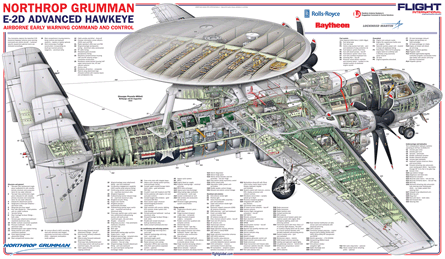Even the Northrop Grumman E-2D Advanced Hawkeye's top salesman does not try to argue the carrier strike group's half-century-old design for an airborne early warning platform is attractive.
Northrop vice-president for AEW and battle management Jim Culmo is frank. The E-2D "may not be the nicest-looking airplane," he says, and the cabin for the five-person crew "is never going to be a luxury liner". Culmo's larger point, however, defines why the E-2D's supporters think the aircraft is worth every cent of the nearly $4.2 billion budgeted throughout an extended development programme.
|
|---|
"The most important thing is getting the capability and doing the mission," Culmo says.
Considering how the carrier-based AEW mission has evolved and increased in complexity since the introduction of the Grumman E-2A in January 1964, the continuity of the basic Hawkeye airframe is no small feat of engineering. Until the last decade, it was enough for the carrier's long-range aerial sensor to be on guard primarily for incoming airborne threats over water. But the mission has expanded dramatically.
In addition to the traditional threats, aircraft carriers in the modern age must be watchful for low-flying cruise missiles, exo-atmospheric ballistic missiles and tracking targets in the clutter-filled zones of the littoral and overland deep beyond the coastlines.
Yet, so much about the E-2D's dimensions and volume seem familiar despite the demand for increased performance. Constrained by the merciless geometry of the carrier deck, the fourth major iteration of the Hawkeye retains the identical 28m (80ft)-wingspan and 7.3m-diameter antenna of past designs. Moreover, the requirement for power output by the Rolls-Royce T56 engine series has grown by only 1,000shp (745kW) over nearly 50 years.
Nonetheless, the E-2D will perform the modern AEW mission with a 26,800kg (57,500lb) maximum take-off weight that one of its competitors - namely, the Boeing 737 advanced early warning and control platform - needs 63,280kg of combined mass for airframe, mission payload and fuel to execute.

DESIGN CHALLENGE
Designing an all-new airframe to replace the E-2C was considered, but dropped for budgetary reasons. It is not just the challenge of designing an AEW platform to fit aboard the carrier that forces the navy to stick with the Hawkeye platform. Qualifying a new aircraft to take off, land and operate from a carrier is still a risky and costly business.
A new, carrier-based airframe requires "an expensive test programme" says Stan Zoubek, Northrop's engineering director for the E-2D. "There has to be quite a capability increase to justify that."
To enable the transformation of the Hawkeye platform to meet the modern threat within the confined area of the aircraft carrier, the E-2D introduces a suite of innovations into the radar, antenna, processors and the cockpit.
HYBRID APPROACH
The hybrid design approach for the E-2D radar perhaps typifies how Northrop matched the technology available at contract signing in 2002 and the needs of the mission.
Although mechanically scanned arrays are growing obsolete, technology does not yet exist for a UHF-band (300MHz to 1GHz) electronically scanned array (UESA) to fit within the size and weight limits aboard the Hawkeye airframe. At the time Northrop launched the programme, it was reported that a UESA system would require 27 transmit modules to achieve 360e_SDgr coverage.
Northrop has installed a combination of radar systems in a variable speed rotodome. There is a mechanically scanned L-3 Communications Randtron ADS-18 antenna that sweeps in 360e_SDgr for all radio frequency emissions. In addition, the 18-channel Lockheed Martin APY-9 electronically scanned array scans for airborne objects across an arc up to 90e_SDgr wide.
The rotodome is designed to spin at three different speeds, completing a full revolution either every 10s, 12s or 15s. The crew also has the option to stop the rotodome. This allows the radar to focus all the energy provided by the E-2D's twin 170kVa generators, which can each surge to 225kVa for up to 3h, into a targeted area. Concentrating the beam allows the radar to either find smaller targets closer-in, or pick up larger targets at far greater ranges.
It is this unique combination of mechanical and electronic scanning that allows the E-2D to more than double the range of the previous APS-145 radar on the E-2C. Neither Northrop nor navy officials disclose the range of the APY-9, but it is listed as beyond 300nm (555km) and appears only constrained by the distance to the horizon at the E-2D's mission altitude of 25,000ft.
Complementing the more capable transmitter, Northrop also added digital, low-noise receivers to improve the sensitivity of a more diverse set of radar targets. With more power, a more capable transmitter and digital receivers, the E-2D would need a far more capable back-end processor to filter through a huge increase in signal noise or clutter.
"As you increase the power, [radar] clutter goes up as much as targets," says Culmo, adding the overland mission is a particular challenge. "If you don't do something to cancel the clutter better, you get nothing from increasing the [radar system's] power."
|
|---|
Jamming larger computer processors with more capability into the cabin was not an option. The problem was solved by introducing space-time adaptive processing (STAP).
This is a technique that uses algorithms to isolate clutter and either intentional (jamming) or unintentional interference. The algorithms separate moving targets from static noise, allowing the radar to "see" clearly even amid dense clutter and high power levels.
"It takes in all the background clutter and jamming and adjusts automatically the gain and phase of the antenna such that it optimally cancels clutter and jamming at the same time," Culmo says.
By adding STAP techniques, Northrop solved another problem in the quest to insert a package of modern AEW capabilities into the Hawkeye platform. STAP has been in testing for a decade, with a Lockheed Martin NC-130 equipped with a saucer-shaped radome serving as the testbed.
Not all the size and volume limitations of the Hawkeye could be overcome with clever design for the E-2D. The Advanced Hawkeye will never match the 10-person crew of the Boeing 737 AEW&C, for example.
The length of the E-2D remains fixed at the Hawkeye's standard 17.5m, with barely enough room to squeeze in seats and displays for three mission consoles directly beneath the radome.
"It made us optimise the [human-machine interface] within the aircraft to allow them to a very complex command and control mission with only three operators," Culmo says.
He considers the Hawkeye's constrained length to be a blessing in disguise for the export market. The 737 AEW&C has attracted orders from Australia, Turkey and South Korea, but Culmo insists that some foreign buyers may prefer a smaller mission crew.
"A lot of these countries don't have the manpower that the US has," he says. "They can't afford to have large numbers of people supporting the aircraft."
Meanwhile, the USN will operate an aircraft with new workstations featuring 20 in (508mm) displays, along with an open architecture computing environment. But Northrop also mitigated the workload on the crew by extending the mission system into the cockpit.
The Hawkeye pilot and co-pilot have been functionally and physically removed from the command and control mission, with a operators' compartment separated from the cockpit by a mission avionics rack.
DIFFERENT ROLES
Across the USN, aviators are being asked to perform in roles previously reserved for specialised operators. A good example is the two-seat EA-18G Growler, which replaces the four-seat EA-6B. Instead of two crew members in the EA-6B focused on the escort jamming function, the task is now left to the back-seater of the EA-18G.
With the greater demands on the E-2D mission, however, the Hawkeye platform also has been adapted to allow an unoccupied member of the flightcrew to participate in the mission.
The cockpit now has three multifunction displays, each measuring nearly 17in across. Any of the displays can be set up to show the same picture seen by the command and control operators in the crew compartment.
"We had to change some font sizes, but all the controls are the same," Zoubek says. "We made the fonts bigger to make them readable."
Although there were initial concerns about the large area displays in the cockpit proving rugged enough, the systems have passed qualification tests, Zoubek adds.
The radar, processors and workstation changes were required for the E-2D to meet its expanded set of requirements. One of the advantages of the Hawkeye's five-decade-old continuity is many recent upgrades arrived with the last version of the aircraft.
The E-2C Hawkeye 2000, for example, introduced several improvements. A passive and obsolete electronic support measures system was replaced with the ALQ-217. The same system can be found on the E-2D.
Another key upgrade rolled into the E-2D was the Hawkeye 2000's propulsion system, which added the eight-bladed Hamilton Sundstrand NP2000 propeller to the 5,100shp Rolls-Royce T56-A-427 engine.
From a structural and systems installation standpoint, the transition from the E-2C to the E-2D required more changes than may be apparent at first glance.
The Hawkeye platform's distinctive tail assembly, featuring four vertical fins on an anhedral horizontal tail, remains untouched, as programme officials worked hard to maintain the aerodynamics of the aircraft.
The tail assembly survived fairly significant changes to the pylon that supports the rotodome. The E-2D rotodome antenna is slightly lighter compared with the E-2C, as the transmitter and receiver modules for the APY-9 are inside the cabin. But the 18-channel rotary coupler for the APY-9 is much larger. This required Northrop to install a fairing around the pylon.
The structural change apparently did not change the airflow over the tail, however. "Even from the beginning, when the test pilots came back, they said it feels exactly like an E-2C," Zoubek says.
Although the E-2D antenna is slightly lighter, the overall weight of the radar system is heavier by about 550kg (1,200lb). That weight is supported by an I-beam that runs longitudinally along the length of the cabin. The I-beam must be designed stiff enough to support the load, yet with enough flexibility to absorb the stress of repeated carrier landings.
"That was a design challenge," Zoubek says. "It took a lot of care and a lot of interaction with Lockheed."
DEVIATION
Another obvious deviation on the E-2D outer-mould line is atop the fuselage slightly forward of the rotodome and aft of the cockpit. A second air intake has been attached on top of the inlet for E-2C's heat exchanger, and is part of Northrop's solution to the E-2D's higher cooling requirements given the increase in transmitter and processing power.
Cooling systems have bedevilled the Hawkeye programme from its inception in the late 1950s. The E-2As were grounded, partly until a working cooling system was introduced with a package of upgrades. After they were installed, the aircraft were redesignated the E-2B. In 1971, the E-2C was introduced with a permanent solution for the cooling problem.
The E-2D has also faced its own share of cooling-related problems, despite upgrading the cooling system for the radar to a polyalphaolefin-based liquid cycle.
A problem came up in flight tests after it was found that one of the components in the radar transmitter required a lower operating temperature than Northrop's engineering team expected. The problem was solved by re-routeing the coolant to pass through that part of the transmitter earlier, when the coolant's temperature would be lower.
It was a fairly straightforward design problem to solve, but an apparent misunderstanding about the scope of the cooling problem reverberated across the programme. Considering the problem as serious, the US Congress in 2008 stripped one-third of the programme's production funding for the first and second years of low-rate initial production (LRIP).
The budget cut for LRIP-2 was restored in last year's appropriations cycle, but the damage to the programme's schedule and ramp-up cost remained.
In addition, the USN changed the definition for initial operational capability for the E-2D to be a full squadron that had already passed an operational evaluation. As a result, the E-2D's in-service date has slipped to the last quarter of 2014, or more than three years later than scheduled.
E-2D CUTAWAY
Source: Flight International























